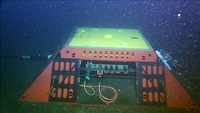Nevion transports live HD underwater video for Monterey Bay Aquarium Research Institute

The Monterey Bay Aquarium Research Institute (MBARI) recently transmitted live HD video and research data from deep under the ocean using a video transport solution from Nevion.
Installed by the Woods Hole Oceanographic Institution, a Nevion Flashlink frame containing ETH-1000 Gigabit Ethernet-to-fiber converters operating on DC power is submerged 3000ft below the surface of the Pacific Ocean at Monterey Bay in California. A 32-mile long fiber-optic cable connects the undersea equipment to a second Flashlink frame on the shore, which is identical except for running on AC power.
The solution provides two bidirectional Gigabit Ethernet connections between the two units for transporting HD video over IP from remotely operated underwater vehicle cameras and telemetry data from research instruments on the ocean floor. The videos and telemetry data are used by scientists and engineers conducting deep-sea research and ocean engineering.
The installation is part of MBARI’s Monterey Accelerated Research System (MARS) Ocean Observatory Test Bed. With traditional oceanographic instruments on the sea floor having to run on batteries and store their own data, it’s impossible for researchers to know whether their instruments are working properly or to control them while experiments are underway. By providing electrical power and data connections, the
MARS cabled observatory removes these restrictions, allowing scientists to study the ocean in new ways. The high-speed data connection allows researchers to receive large amounts of data, including digital video streams, and control and assess their instruments — all in real time.
MARS serves as an engineering, science and education test bed for other ocean observatories, allowing scientists to perform real-time experiments nearly 3000ft below the surface of Monterey Bay.
The professional video industry's #1 source for news, trends and product and tech information. Sign up below.
